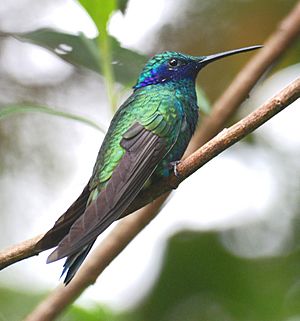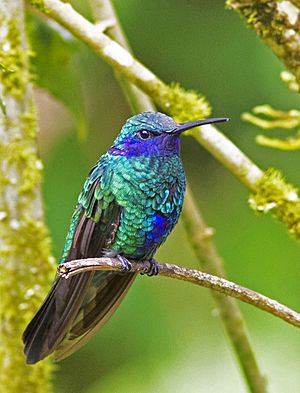Sparkling violetear facts for kids
Quick facts for kids Sparkling violetear |
|
|---|---|
 |
|
| Conservation status | |
| Scientific classification | |
| Genus: |
Colibri
|
| Species: |
coruscans
|
 |
|
The sparkling violetear (scientific name: Colibri coruscans) is a beautiful type of hummingbird. You can find these birds mostly in the high mountains of northern and western South America. This includes a big part of the Andes mountains, stretching from Argentina all the way north. They also live in the Venezuelan Coastal Range and on flat-topped mountains called Tepuis.
These hummingbirds live in many different open areas. You might even spot them in gardens and parks in big cities like Quito. Often, they are the most common hummingbird species in the places they live. Sparkling violetears love to sing loudly and protect their own space.
Contents
About the Sparkling Violetear
Family Tree and Types
The sparkling violetear has two main types, called subspecies. They are C. c. coruscans and C. c. germanus. Scientists have suggested other types, but these two are the most widely accepted.
What They Look Like
The sparkling violetear is the biggest type of violetear hummingbird. It grows to be about 13 to 14 centimeters (5 to 5.5 inches) long. Male birds weigh between 5.8 and 8.5 grams. Females are a bit lighter, weighing 6 to 7.5 grams.
The males have shiny bluish-green feathers on their backs. Their chin is a pretty bluish-violet color. Their belly is blue, and the rest of their underside is green. Their tail is metallic green with a dark blue band near the end. Females look similar but are a bit smaller. They often have a small white spot behind their eye. The C. c. germanus subspecies looks much like the main type. However, its forehead, underside, and tail feathers are a bit bluer.
Where They Live and Their Home
The main type of sparkling violetear, C. c. coruscans, lives in many places. You can find it in Venezuela's Sierra de Perijá mountains. It also lives in Colombia's Sierra Nevada de Santa Marta. These birds are common in the Andes mountains. Their range stretches from Venezuela through Colombia, Ecuador, Peru, and Bolivia. They even reach northern Chile and northwestern Argentina.
The C. c. germanus subspecies lives on the tepuis. These are the flat-topped mountains in southern Venezuela. They are also found in western Guyana and a nearby part of Brazil called Roraima. Sparkling violetears live in many open areas. These include the edges of forests, woodlands, gardens, and city parks. They also live in high-altitude grasslands called páramo. They usually live at heights from 1,000 to 4,500 meters (3,300 to 14,800 feet) above sea level.
How They Live
Body Wonders
Sparkling violetears can get very cold at night to save energy. This is called torpor. During cold nights in high mountains, their body temperature can drop to about 8 degrees Celsius (46 degrees Fahrenheit). This is much colder than their daytime temperature of about 36 degrees Celsius (96 degrees Fahrenheit). This special ability helps them survive cold nights.
Movement and Travel
Some sparkling violetears live in the páramo grasslands. During the dry season, they might move to lower areas, around 2,000 meters (6,600 feet) high. Other groups of these birds that live below the páramo usually stay in the same place all year. They might make only short trips.
What They Eat
Sparkling violetears drink nectar from many different types of flowers. They find food at all levels of the forest, from the ground to the very top. They also catch insects while flying. These birds can be very aggressive. They often chase away other hummingbirds to protect flowering trees. However, they are not usually aggressive in the páramo areas.
Life Cycle and Reproduction
The breeding season for sparkling violetears changes depending on where they live. In Venezuela, they breed from July to October. In Argentina, it's from December to February. They build a cup-shaped nest using soft plant materials. They often decorate the outside with small mosses called lichens. The nest is usually placed on a horizontal branch or a hanging twig. Sometimes, they build it in a crack in rocks.
A female sparkling violetear usually lays two eggs. The eggs hatch after about 17 to 18 days. The young birds are ready to fly about 20 to 22 days after they hatch. While some reports say male birds help care for the young, this has not been fully confirmed by scientists.
Their Songs and Calls
The sparkling violetear is a very noisy bird! Its main song is a long series of metallic "chips." It sounds like "djit...djit...djit..." or "tlik...tlik...tlik..." When they fly in special ways to attract a mate, they sing a mix of chips, squeals, gurgling sounds, and short warbles. Their call is a short, dry rattling sound, like "drrr...drrr..."
Conservation Status
The IUCN (International Union for Conservation of Nature) says the sparkling violetear is a species of "Least Concern." This means they are not currently in danger of disappearing. We don't know exactly how many there are or if their numbers are changing. However, they are common in many places, including gardens and farms made by people.
See also
 In Spanish: Colibrí rutilante para niños
In Spanish: Colibrí rutilante para niños



